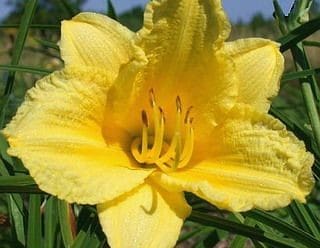Looking at the cover of the winter issue of Garden Making magazine reminds me that intelligent garden design is so often executed in small and personal details, with plants that blend into comfortable landscapes and show the gardener’s skill and attention. All gardening involves design, even if we’re only placing plants in a border or curving a formerly straight line.
In the cover photograph, I can see the gardener’s hand in the shaped boxwoods, the espaliered magnolia and the white geraniums chosen to echo the painted structures. Possibly the most intriguing element in the cover photograph is the ball and chain counter balance on the gate, a practical and small architectural detail that references colonial gardens, and a good choice for the broad panelled gate.
Images like the winter issue’s cover inspire us to interpret design ideas in different venues and with a variety of plants.
A garage wall could be espaliered with a flowering shrub—try flowering quince, mock orange (Philadelphus spp. and cvs.), firethorn (Pyracantha spp. and cvs.), cotoneaster, viburnum, forsythia or ‘PJM’ rhododendron (a tall, rangy plant).
Inspiration could carry this idea further into making a living fence—a free-standing, post-and-wire structure espaliered with a flowering shrub or fruiting vine (grapes or hops, for example). For simple instructions on how to espalier ornamental and fruit plants, see http://msucares.com/pubs/publications/p0456.pdf.
Low plants pruned into soft mounds are good design “markers” to emphasize a path, frame the top or bottom of a short flight of steps, or mark the transition from one garden area to another. We could develop that idea using globe cedar (try Thuja occidentalis ‘Little Giant’, ‘Golden Globe’ or ‘Danica’), dwarf yew, ‘Sarcoxie’ euonymus or Mugho pine. You could extend the concept to a conical form by using upright boxwood (‘Green Mountain’ or ‘Winter Beauty’), or narrow columnar ‘Degroot’s Spire’ cedar.
Garden design works best when you consider a good example, and then adapt it for your own purpose. The photo on the cover as a whole is certainly beautiful, but the glory is in the useful details.
Gambling with magnolias

About a decade ago I had a nice collection of six magnolias. Among them were two species plants I dearly loved, the white star magnolia (Magnolia stellata, 13 x 10 feet/4 x 3 m, Zone 5) with lemon-scented, strappy petals, and the shrub-form Oyama magnolia (M. sieboldii, 10 by 10 feet/3 x 3 m, Zone 6) with creamy white, bell-shaped flowers surrounding burgundy stamens. Then came a plague of magnolia scale, and all were killed in the space of two summers.
I’ve experienced other insect invasions that have decimated families of plants, like the viburnum beetle, and I know these massive incursions are cyclical; gardeners must patiently wait them out. So I’ve been waiting a long time, and it’s been cold comfort to see my neighbour’s two magnolia trees entirely free from scale while the pestilence raged on my side of the road. Was my little magnolia farm a monoculture for scale? Or was it just the way the wind blows, and the scale insects all landed in my garden?
Well, I don’t know, but I’ve decided to toss the dice and gamble with magnolias again. Last year I planted a cute little magnolia called ‘Susan’ (M. x ‘Susan’, 8 x 8 feet/2.5 x 2.5 m, Zone 5), with reddish-purple flowers, and so far no scale insects have found it. This year I’ve increased the bet with a yellow ‘Butterflies’ magnolia (M. acuminata ‘Butterflies’, 20 by 13 feet/6 m x 4 m, Zone 5), a jewel of a tree with bright yellow flowers and red stamens. Plant experts describe ‘Butterflies’ as a precocious bloomer, meaning it will flower when quite young—now, is there any greater encouragement?
Pressing my luck, I plan next spring to mount a search for ‘Forrest Pink’ (M. x soulangiana ‘Forrest Pink’, 16 x 13 feet/5 x 4 m, Zone 5), which grows in the garden of my friend Marilyn S., and is the most sweetly scented magnolia I’ve ever encountered. And then, if all is well and no scale insect dares to show itself, I’ll try to find another Oyama magnolia, because those creamy nodding bells are irresistible. Does this sound like the beginning of a new collection? You might say I’m becoming emotionally invested in these magnolias, but that’s the way it is with beautiful trees. You’ve got to up the ante, and love them.
Still blooming in my garden: ‘Happy Returns’ daylily

• Another gas station plant, ‘Happy Returns’ daylily (Hemerocallis ‘Happy Returns’, Zone 3), is still blooming on three stems with lemon-yellow scented flowers. Despite two nights of light frost, it keeps on going. I’m particularly surprised that it’s able to retain scent in the cold air. The message is clear: I should get more of this.
• Do you know the calamint family? They’re cousins to mint, but without running roots; they make airy fillers (looking like dwarf baby’s breath) around rocks and between shrubs. Mine is dwarf calamint (Calamintha nepeta var. nepeta, syn. C. nepetoides, 12 x 12 inches/30 x 30 cm, Zone 5), sometimes called thousand-flowered aster because of the multitudes of tiny pale mauve flowers that open in early summer and keep on blooming. (This was recommended to me by John Valleau, horticulturist at Heritage Perennials, www.perennials.com.) Everything about this plant smells minty-good, and it’s a prodigious nectar producer that was a magnet for Red Admirals this summer. Now the season’s final honeybees are duking it out all over the flowers.
I’ve enjoyed having you visit at Garden Making, and please come again!

To Anne, Nov. 11
Thanks for the heads up, and I will be ***very disappointed*** if I encounter these critters again. However the threat does get me thinking of what to do about it.
Here is a web site with good information and pictures of what we’re up against: http://woodypests.cas.psu.edu/factsheets/insectfa… .
Good luck to us all — this is war!
Judith, you've likely already heard but please check your magnolias closely … magnolia scale is back and just starting this past summer in Toronto. I have a mature soulangiana that was severely hit during the last round and has been caught again this summer. Hopefully with early spraying, we can save it again!
Anne